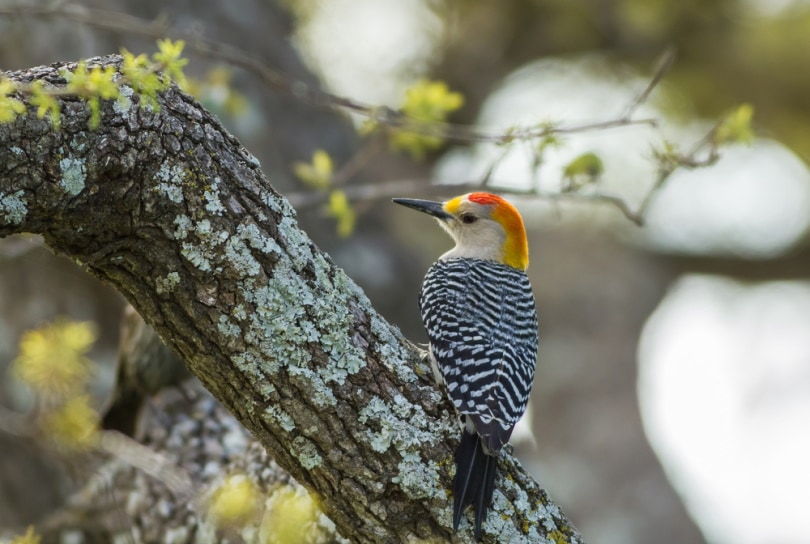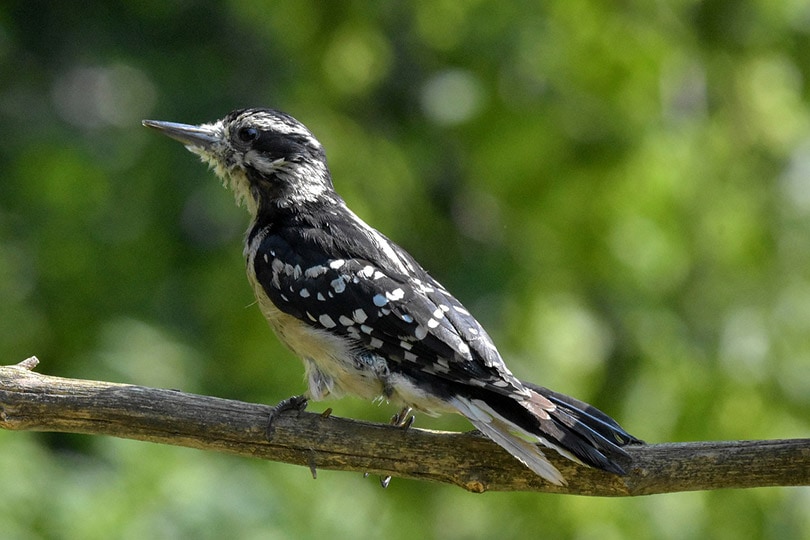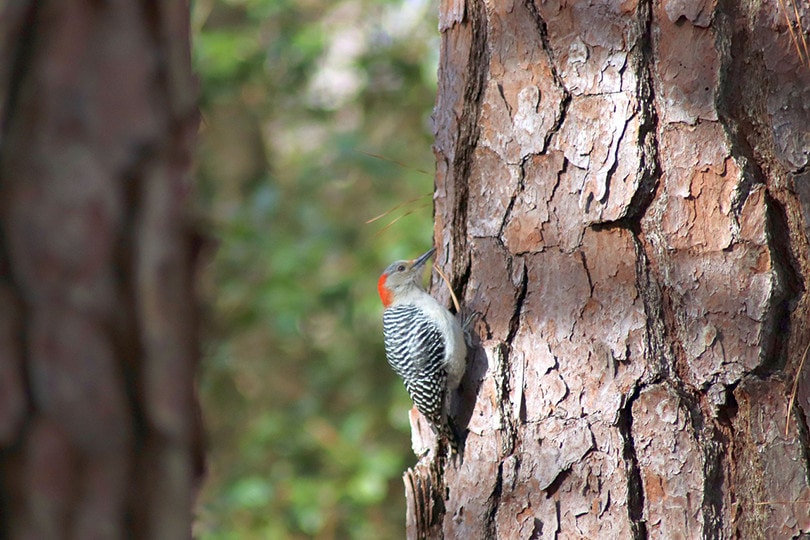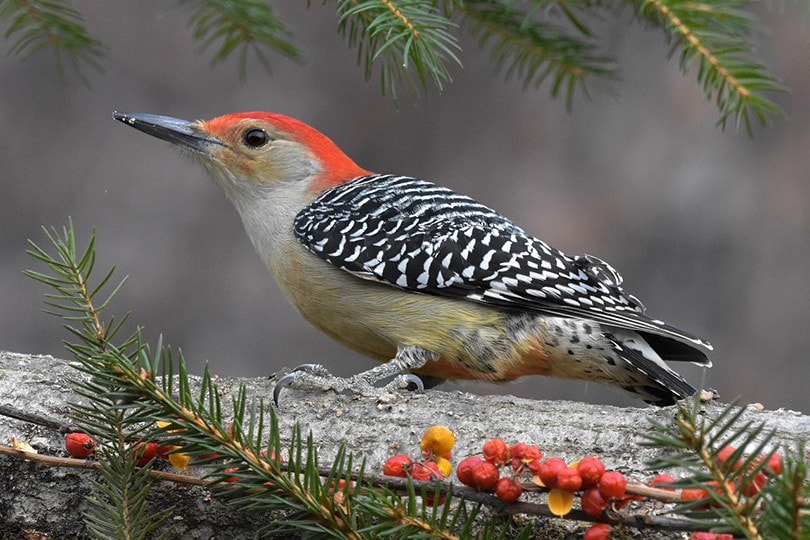12 Species Of Woodpeckers In Texas (With Pictures)
Last Updated on

According to the International Ornithological Committee, there are 239 different woodpecker species in the world. They are all part of the Picidae family, with the largest species being the Imperial woodpecker.
The rarest of them all is the Ivory-Billed woodpecker, and it’s only been spotted once in the United States. That was way back in 2004, and the reason why researchers are speculating that maybe they were simply migrating to a different part of the world.
North America is home to 23 of the 239 species, and from what we’ve learned, 12 of them have settled in Texas. If you’d like to learn a thing or two about these 12 species, this is the article for you.

The 12 Woodpeckers Species In Texas
1. Northern Flickers

| Weight | 3.9–5.6 oz |
| Length | 11–12.2 in |
| Diet | Nuts, fruits, and insects |
This woodpecker is migratory in nature—you’ll find the same species in Central America, the Cayman Islands, and Cuba. They are relatively large, with distinctive body colors. You’ll quickly notice the feathers are golden, and they all have a black crescent-looking patch on their breasts.
The Northern Flicker’s natural habitat is open woodland. However, they won’t mind spending time at the park or your garden. Even though they are woodpeckers, you’ll sometimes find them foraging the same way a flycatcher would, or snatching food from other birds. Needless to say, they aren’t social.
2. Pileated Woodpecker

| Weight | 8.8–12.3 oz |
| Length | 15.8–19.3 in |
| Diet | Nuts, fruits, and insects |
Northern Flickers are large, but not as large as the Pileated Woodpecker. As a matter of fact, this species has been listed as the largest in not just Texas, but North America as well. That spot was initially reserved for the Ivory-Billed Woodpecker, but it’s possible they might have gone extinct.
The Pileated Woodpecker is usually found in Houston or in cities that are north of Houston. They really love hanging around old trees and dead rotting woods. You can lure them to your backyard if you have suet. They do love them, but they’ll stay in the forest if their natural food sources aren’t depleted.
3. Hairy Woodpeckers

| Weight | 1.4–3.4 oz |
| Length | 7.1–10.2 in |
| Diet | Tree sap and insects |
We think a lot of people have fallen in love with the Hairy Woodpecker because of the kind of energy they exude. They have a ‘soldierly’ posture and are not as aggressive as some other species—though the Downy Woodpecker might disagree. We aren’t sure why, but these two don’t get along, which is strange considering they are close cousins.
Hairy Woodpecker likes to eat insects (that are mostly found in wood) and trap sap. Suet is an alternative that you can use to lure them, if you can’t find sap.
4. Downy Woodpeckers

| Weight | 0.7–1.0 oz |
| Length | 5.5–6.7 in |
| Diet | Omnivore, Insectivore |
The Downy is a tiny species of woodpecker. Not the tiniest, but tiny nonetheless. It’s easy to spot one, seeing as they are almost everywhere on the continent.
Most people confuse them with the Hairy Woodpeckers because they have the same body color—back and white. Of course, they are smaller in size, but that’s not enough to go on, especially if you’re trying to identify one. You could be looking at a baby Hairy Woodpecker, thinking it’s a Downy. The trick is to pay attention to the sound it produces. If you hear “kee kee” or “pik pik,” you’re probably looking at a Downy.
Downies are non-migratory, and they love to visit backyard feeders. Their natural habitats are deciduous woodlands.
5. Red-Headed Woodpecker

| Weight | 2.0–3.2 oz |
| Length | 7.5–9.1 in |
| Diet | Berries and insects |
Most people can easily identify a Red-Headed Woodpecker. Its entire head is crimson or red, and they are experts at catching insects mid-flight. We however wouldn’t encourage you to invite them to your yard, since they are very aggressive. They’ll have no problem invading the private spaces of other birds or even breaking their eggs.
Red-Headed Woodpeckers love fruits and nuts, and are among the few bird species that hoard food for later use. Hoarding is actually part of their lifestyle, and they can go as far as hiding their stash using wood and bark.
The Red-Headed Woodpecker could possibly be the most aggressive of all the woodpecker species out there.
6. Acorn Woodpecker

| Weight | 2.3–3.2 oz |
| Length | 7.5–9.1 in |
| Diet | Insects and acorns |
The Acorn species is not as widely spread out as some of the other species. Even in North America, they can only be spotted in certain regions. In Texas, we only get to see them when we visit pine and oak forests located in the east. As you might have guessed, they love eating insects and acorns.
The most distinguishable behavior of the Acorn woodpecker is that of drilling holes in trees. The holes are their granaries, meant to help them store and hide nuts from other birds. A hardworking Acorn woodpecker can hide up to 5,000 nuts! And they’ll be jammed up so tight that no other animal will be able to remove any.
7. Yellow-Bellied Sapsucker

| Weight | 1.5–1.9 oz |
| Length | 7.1–8.7 in |
| Diet | Tree sap, insects, and fruits |
Genetically, the Yellow-Bellied Sapsucker is closely related to the Red-Naped and Red-Breasted Sapsucker. The bright yellow color on their bellies is the reason they were given that name. Funny thing is, the males don’t have it. They only have white on their underparts and breasts. Thus, making differentiating the males from the females a lot easier.
Sadly, the Yellow-Bellied Sapsucker is not a permanent resident in Texas. They come during summer and move on in winter.
8. Golden-Fronted Woodpecker

| Weight | 2.6–3.5 oz |
| Length | 8.7–10.2 in |
| Diet | Insects, fruits, eggs, and seeds |
If you’d like to see the Golden-Fronted Woodpecker all year round, you should move to Central America or Mexico. In Texas, just like several other birds, they can only be seen during summer, and they’ll only occupy the brushlands of central Texas or open woodlands. They are not common in the US, and they’re only found in two states.
Telling the males and females apart won’t be easy, owing to the fact that they both have yellow napes and backs that are barred black and white. Golden-Fronted woodpeckers will eat the eggs of other birds, if they can’t find seeds or insects.
9. Red-Naped Sapsucker

| Weight | 1.1–2.3 oz |
| Length | 7.5–8.3 in |
| Diet | Omnivore, Insectivore |
Researchers once considered this species a subspecies of the Yellow-Bellied Sapsucker. They thought it had traits that made it difficult to merge it with other woodpeckers, but that confusion has since been resolved. It’s now classified as a distinct species.
Compared to all the other woodpeckers, they are of medium size. Their main delicacy is tree sap, but they’ll also eat insects and berries from time to time. Their bodies are mostly black, but the throat, nape and forehead are all red in color.
10. Red-Cockaded Woodpeckers

| Weight | 1.5–1.8 oz |
| Length | 7.9–9.1 in |
| Diet | Nuts, seeds, insects, and fruits |
Spotting the red color of these bords won’t be easy, unless you’re close enough. If you’re not an experienced researcher or an avid birder, you’ll just think it’s a different species. Most of its body is covered in black and white colors. The redness is mostly visible in males, if you take a close look at their black caps.
The Red-Cockaded is listed as either endangered or nearly threatened. Natural destruction of their habitats is what has been listed as the cause of their dwindling population. So if you see one, don’t try to capture it. They are non-migratory and prefer building homes in the pine savannas.
11. Red-Bellied Woodpecker

| Weight | 2.0–3.2 oz |
| Length | 9.4 in |
| Diet | Omnivore, insectivore |
The Red-Bellied Woodpecker can be found on the eastern side of the country, or in east Texas. Confusing them with the Red-Headed species is impossible, since they don’t have any red color on their head. It’s just on the belly, and it’s not even a dark shade.
Luring them to your backyard will be easy if you have suet. They love it more than the sunflower seeds found in the wild. They’ll sometimes feed on nectar if the food banks are running low.
12. Ladder-Backed Woodpeckers

| Weight | 0.7–1.7 oz |
| Length | 6.3–7.1 in |
| Diet | Omnivore, insectivore |
The Ladder-Backed species has wings with patterns that resemble a ladder—a black and white ladder, to be precise. The females are not as aggressive as the males, who fight often with other woodpecker species.
The bird is non-migratory and prefers living in deserts or bushy areas. Most of them are found in the west of Texas. Also, spotting them in winter is not easy, as they are less active.

Conclusion
Texas has over 600 bird species, making it the most bird-diverse state in the country. If you’d like to interact with some of these birds, just come visit. We promise you’ll have a good time and appreciate nature more.
The 12 species that we’ve talked about today, are part of all the five native genera. So if you want them to pay you a visit, purchase a feeder, and leave them a few sunflower seeds. In a day or two, they’ll transform your backyard into a paradise.
Featured Image Credit: Warren Price Photography, Shutterstock
Table of Contents
About the Author Robert Sparks
Robert’s obsession with all things optical started early in life, when his optician father would bring home prototypes for Robert to play with. Nowadays, Robert is dedicated to helping others find the right optics for their needs. His hobbies include astronomy, astrophysics, and model building. Originally from Newark, NJ, he resides in Santa Fe, New Mexico, where the nighttime skies are filled with glittering stars.
Related Articles:
Monocular vs Telescope: Differences Explained (With Pictures)
10 Types of Hummingbirds in Arkansas (With Pictures)
8 Types of Hummingbirds in Nebraska (With Pictures)
5 Types of Hummingbirds in Idaho (With Pictures)
3 Types of Hummingbirds in Mississippi (With Pictures)
8 Types of Hummingbirds in Kansas (With Pictures)
5 Types of Hummingbirds in West Virginia (With Pictures)
5 Types of Hummingbirds in Ohio (With Pictures)
